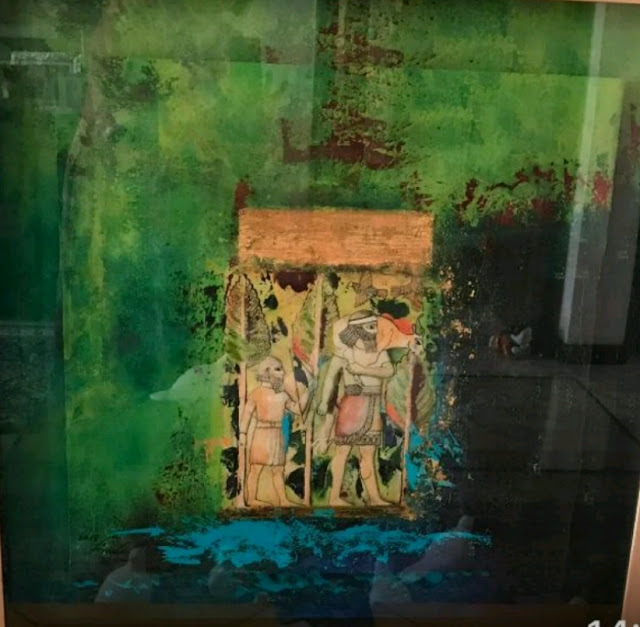نخلة عراقية باسقة في
البحرين
الفنانة التشكيلية
فريال الاعظمي
تتلو رسائل بابل
وبفرشاتها ترتسم
كلماتها برافدين العراق
على رافديك اتلو رسائل بابل
المعرض الشخصي للفنانة
فريال الاعظمي
وهل لي إلاكَ يا عراق
على رافديه أتلو
فوق أسوار الحنين
روحي معلقة تشدو
حسبت أني إذا غادرتك
من عذاباتي أنجو
وجدتك على أطراف قلبي
مثل النخيل تنمو
وهل للمصاب بحمى
العراق من شوقه
ينجو
“ لؤي طه"
بسرور
تملأه الغبطة أدعوكم أحبتي في البحرين وجيرانها ولكل من لهم في القلب ركن لحضور
معرضي " على رافديك أتلو رسائل بابل" والذي سيقام في البارح للفنون تحت رعاية معالي
الشيخة مي بنت محمد آل خليفة يوم الأربعاء الموافق في 3 ابريل في تمام الساعة
السابعة مساء
يزهو
المكان بكم وتتعطر زواياه بحضوركم
الفنانة التشكيلية
فريال الاعظمي
--------------------------------------
صفحتها الرسمية على الفيسبوك
------------------------------------------------------
نبذة باللغة الانكليزية عن المعرض
FOR IMMEDIATE RELEASE
Firyal Al Adhamy’s
Rhythms of Mesopotamia
Opens at Albareh Art
Gallery
Albareh Art Gallery is pleased to announce
the opening of Iraqi British artist Firyal
Al Adhamy’s solo exhibition Rhythms
of Mesopotamia with a reception at 7:00 p.m. on Sunday, April 7, at its
gallery in Adliya.
This is Al Adhamy’s second solo show at
Albareh. The first, Postcards from Mesopotamia in 2006, was an expression of Al
Adhamy’s sadness and outrage over the plundering of Iraqi artefacts following
the US invasion of her homeland. In her
latest exhibition, Rhythms of
Mesopotamia, Al Adhamy revisits her first show, both in concept and in form,
documenting how both have grown and changed in that time.
In her artist statement, Al Adhamy describes a
visit to an exhibition, I am Ashurbanipal,
held at the British Museum in 2018. As
she walked through the exhibits, she was overwhelmed by a sense of loss over
having to view the artefacts of her Iraqi heritage in a country far away from her
own. Upon reflection, that feeling was
replaced by relief that the same Iraqi artefacts are safe and have been
preserved for posterity, albeit in a foreign land. This process of reflection inspired her to
revisit her 2006 exhibition, Postcards
from Mesopotamia, reworking the pieces that she had produced then, using
them as the basis for the creation of new works derived from the older ones,
this time from a more mature, more reflective and resigned vantage point.
Retaining the older images as a base, Al Adhamy
refreshes the colours, embellishes the surfaces with gold leaf and texture, and
layers new concepts on the old in an attempt to start the healing process of
the pain experienced over the loss of her cultural symbols.
Firyal Al Adhami is an Iraqi British artist
born in Baghdad. Her work is inspired by Iraq’s rich history, and by a desire
to document and preserve this richness for future generations.
Since 1988, Al Adhamy has
contributed to a significant number of group exhibitions on both regional and
international levels. She has also had ten solo exhibitions. Her work features
in public collections such those of the British Museum, the Arab British
Chamber of Commerce (London, UK), the American-Arab Anti-Discrimination
Committee (Washington DC, USA), the National Gallery of Fine Arts (Amman,
Jordan), Bait Al-Qur’an (Bahrain), and the Jeddah International Airport
(Kingdom of Saudi Arabia), as well as numerous private collections. Al Adhamy
lives and works in Bahrain.
Rhythms of Mesopotamia continues at Albareh Art Gallery till
__________.
Gallery Hours: Saturday – Thursday 9:30 a.m. – 2:00 p.m. and
4:00 p.m. – 8:00 p.m.
For more
information, please contact:
Name: Hayfa Aljishi
Tel: (+973) 17717707
Rythms of Mesopotamia
Artist Statement
In the summer of 2018, as I walked through the corridors of the British Museum where the exhibition I am Ashurbanipal was on display, I was overwhelmed with shock to see my civilization hanging on marble walls in a foreign country. It felt like seeing parts of my house hanging somewhere else. But then I remembered the looting and plundering of Iraqi artefacts that took place after the war, and I was overcome by relief that these artefacts rest peacefully far from the plunderers of history.
I left the British Museum consumed by the obsession to represent Mesopotamian civilization in Iraqi colours, driven by a great sense of pride in being a descendant of Ashur and an echo of Nineveh. I wanted to express this pride by revisiting and reworking art that I had exhibited in the Kingdom of Bahrain in 2006 in the same space, Albareh Art Gallery, about our looted artefacts in the aftermath of the US occupation of Iraq.
This exhibition is neither a repetition nor a reiteration of the previous one, but rather a return to Iraq's past. It is the return of Iraqis to their rivers, the Tigris and the Euphrates, where Ashurbanipal once sat on his luxurious throne overlooking the balconies of Nineveh and his eternal shadow stretched over the earliest beginnings of civilization.
This is a rekindled artistic experience with new features and colours that reflect the burning sun at the moment when Ashur was consumed by the flames of his ego, and his body was transformed into a fire that burnt perpetually, raging through time.
When artists reintroduce their work, they do not reproduce it, but rather revitalize it. The wider the artist’s vision expands, the better she renews this vision in a way that re-infuses life into the veins of previous works.
This exhibition is an entwined artistic experience of a colour psychology where a new shade is dispersed over an old shade to create a unique impression. For the past is but an extension of the present and a revival of ancient civilizations whereby memory is protected against oblivion. So, remind the passers-by of the Walls of Babylon. May reminiscence be availed, and nostalgia be awakened.










ليست هناك تعليقات:
إرسال تعليق